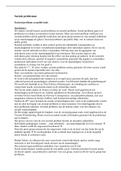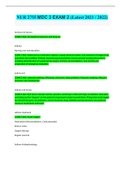Notas de lectura
OCR A level PE revision notes - Biomechanics
- Grado
- Institución
- Book
This document provides notes for the Biomechanics part of paper 1 - physiological factors affecting performance. Hope you find these useful.
[Mostrar más]Vista previa 3 fuera de 17 páginas
Vista previa 3 fuera de 17 páginas
Algunos ejemplos de esta serie de preguntas de práctica
1.
Describe Newton\'s 1st law of inertia
Respuesta: Newton’s first law states that an object will remain at rest or at a constant velocity unless acted upon by an external force. A sporting example is a golf ball on a tee at rest, the golf ball is at rest on tee until acted upon by the force of a golf club (external force). The greater the mass of the golf ball, the higher the inertia of the golf ball.
2.
Inertia
Respuesta: Inertia is defined as the tendency of an object to resist a change in motion
3.
Newton\'s 2nd law of acceleration
Respuesta: Newton’s second law of acceleration indicates that the larger the force applied onto a body, the higher the acceleration of that body. For example, Roger Federer applying a large force onto a tennis ball when serving means that the tennis ball will travel with higher acceleration. Thus having more pace and making the serve harder to return. However, the force of the tennis ball is dependant on the mass of the tennis ball because Force = Mass x Acceleration. A higher tennis ball at the same acceleration will result in a higher force.
4.
Newton\'s 3rd law of action and reaction
Respuesta: Newton’s third law states that for every reaction there is an equal and opposite reaction. For example, a 100m sprinter applies a large force from his foot into the ground and the ground produces an equal and opposite reaction force back onto the 100m sprinter’s foot.
5.
Force
Respuesta: A push or pull that alters state of motion
Algunos ejemplos de esta serie de preguntas de práctica
1.
Describe limb kinaematics
Respuesta: Limb kinematics is the study of movement of limbs in relation to space and time, it uses body markers and multiple cameras from different angles to map body during movement. Specialist computer software can then use footage from cameras to create a 3D image of movement.
2.
Pros of limb kinaematics
Respuesta: Data is accurate and valid for analysis. It gives good detail about technique. It can be used to analyse the technique of a specific limb.
3.
Cons of limb kinaematics
Respuesta: Specialist equipment is very expensive and technical. Accuracy is dependant on marker placement. Some movements can’t be analysed effectively enough. The mathematical process doesn’t consider psychological and physiological makeup.
4.
Force plates
Respuesta: Force plates are metal plates sunk into the ground electrically connected to the a computer, when an object or limb contacts the plate an electrical output is generated and converted into a graph on the computer. On the computer, size, time and direction of forces are showed. This allows reaction forces to be measured (Fx, Fy and Fx).
5.
Pros of limb kinaematics
Respuesta: Data is immediate and accurate Useful for gait analysis of a performer
Algunos ejemplos de esta serie de preguntas de práctica
1.
Levers
Respuesta: rigid structures that move joints
2.
Components of a lever
Respuesta: load, effort and a fulcrum
3.
Mechanical advantage
Respuesta: A mechanical advantage means that the effort arm is longer than the load arm, therefore larger loads can be lifted
4.
Mechanical disadvantage
Respuesta: a mechanical disadvantage means that the load arm is longer than the effort arm. This means that heavy loads cannot be lifted.
5.
1st class lever
Respuesta: Load - Fulcrum - Effort
Algunos ejemplos de esta serie de preguntas de práctica
1.
Linear motion
Respuesta: movement of a body in a straight or curved line, where all body parts are moving at the same speed, direction or time. Linear motion is caused by an external force being applied through the CoM of an object.
2.
Linear motion descriptors
Respuesta: Acceleration Velocity Speed Distance Displacement
3.
Acceleration
Respuesta: the rate of change in velocity, measured in m/s2 Acceleration = ∆velocity/time
4.
Velocity
Respuesta: rate of change in displacement, measured in m/s Velocity = displacement/time
5.
Distance
Respuesta: Length of path taken from start to finish, measured in Metres Distance = Speed x time
Algunos ejemplos de esta serie de preguntas de práctica
1.
Angular motion
Respuesta: movement of a body in a circular motion around its principle axis of rotation, angular motion is caused by an external force being applied outside the CoM of a body.
2.
Axes of rotation
Respuesta: Transverse Frontal Longitudinal
3.
Transverse axis
Respuesta: The transverse axis runs horizontally from side to side, a diver performing a sommersault rotates around the transverse axis.
4.
Frontal axis
Respuesta: The frontal axis runs horizontally from front to back of the body, a gymnast performing a cartwheel will rotate around the frontal axis.
5.
Longitudinal axis
Respuesta: The longitudinal axis runs from top to bottom of the body, a dancer performing a pirouette will rotate around the longitudinal axis.
Algunos ejemplos de esta serie de preguntas de práctica
1.
Fluid mechanics
Respuesta: the study of forces acting on the body travelling through air or water, fluid mechanics can be used to assess the air resistance (AR) acting on a cyclist or Drag (D) on a swimmer. D and AR are slightly different, D is the force that opposes motion through water and AR is through air.
2.
Drag
Respuesta: force that opposes motion through water
3.
Air resistance
Respuesta: The force that opposes motion through the air
4.
Factors of air resistance/drag
Respuesta: 1. Velocity 2. Mass 3. Surface characteristics 4. Front-cross sectional area 5. Streamlining and shape
5.
Velocity
Respuesta: the higher the velocity, the greater the AR or D acting on a body.
Algunos ejemplos de esta serie de preguntas de práctica
1.
Projectile motion
Respuesta: movement of a body through the air following a curved flight path through the air.
2.
Factors affecting the horizontal distance travelled by an object
Respuesta: 1. Speed of release – greater change in momentum and acceleration if a larger force is applied. 2. Angle of release – optimum angle of release is 45o to achieve maximum horizontal distance. 3. Height of release – if release height = landing height, optimal angle of release is 45o, if release height is above landing height then optimal angle of release is below 45o. If release height is below landing height optimal angle of release is above 45o.
3.
Shot put – free body + flight path diagram
Respuesta: 1. For the shot put, Weight (W) is the dominant force and Air Resistance (AR) is minimal therefore the flight path is parabolic, 2. parabolic meaning the flight path curve is symmetrical from release to landing.
4.
Badminton shuttlecock
Respuesta: 1. For the Badminton shuttlecock, AR is the dominant force and W is minimal therefore a non parabolic flight path occurs, 2. a non symmetrical flight path curve shape.
5.
Parallelogram of forces
Respuesta: 1. Draw free body diagram showing W and AR from CoM. 2. Add broken parallel lines to the W and AR to create parallelogram. 3. Draw a diagonal line from CoM to opposite corner of parallelogram, this should be labelled as the resultant force.

Compradores de Stuvia evaluaron más de 700.000 resúmenes. Así estas seguro que compras los mejores documentos!

Puedes pagar rápidamente y en una vez con iDeal, tarjeta de crédito o con tu crédito de Stuvia. Sin tener que hacerte miembro.

Tus compañeros escriben los resúmenes. Por eso tienes la seguridad que tienes un resumen actual y confiable. Así llegas a la conclusión rapidamente!
You get a PDF, available immediately after your purchase. The purchased document is accessible anytime, anywhere and indefinitely through your profile.
Nuestra garantía de satisfacción le asegura que siempre encontrará un documento de estudio a tu medida. Tu rellenas un formulario y nuestro equipo de atención al cliente se encarga del resto.
Stuvia is a marketplace, so you are not buying this document from us, but from seller nathanbates. Stuvia facilitates payment to the seller.
No, you only buy this summary for $6.51. You're not tied to anything after your purchase.
4.6 stars on Google & Trustpilot (+1000 reviews)
45,681 summaries were sold in the last 30 days
Founded in 2010, the go-to place to buy summaries for 14 years now



